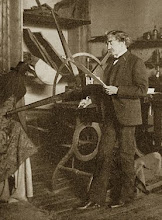 When I wrote previously about describing the restoration of my Kelton copperplate press I mentioned that it was often known as a banknote press. The reason for this is easy to understand: it is specially designed for production printing and was used extensively by banknote and stock certificate manufacturers such as the American Bank Note Company.
When I wrote previously about describing the restoration of my Kelton copperplate press I mentioned that it was often known as a banknote press. The reason for this is easy to understand: it is specially designed for production printing and was used extensively by banknote and stock certificate manufacturers such as the American Bank Note Company.U.S. Bureau of Engraving and Printing
The main production feature is the ability of the press bed to return rapidly to its starting position at the front of the press. To do this a D or half-cylinder is provided on top and the bed is set at a forward slant. The action is further helped by a weight attached to the rear of the bed through a pulley arrangement that pulls the bed back to its starting position. The press is also equipped with an adjustable pneumatic piston and rubber bumper that allow the bed to be gently stopped once the return motion is complete. The pneumatic piston consists of a leather cup washer in a sleeve, very much like the fuel pump on a Coleman stove though much larger.
There is an adjustable pawl on the right side of the upper D cylinder that engages with a corresponding adjustable pawl on the side of the bed. The pawls are adjusted so that when the star wheel is turned, thereby turning the upper cylinder, the bed is moved to the rear as the round part of the cylinder starts to come into contact with it. The pusher blanket is attached around the round part of the cylinder and with the plate on the bed and the other blankets positioned to their ends are caught between the cylinder and the bed as the wheel is turned, the whole is squeezed through the press as with any other intaglio press.
As soon as the D cylinder is turned round far enough that the plate has passed through and the round half of the cylinder leaves contact with the bed, the bed is free to roll back to its original position. In other words, the pressure of the round half of the cylinder pressing on the bed pushes the bed with the plate and blankets through the two rollers. With the flat half of the cylinder facing down, there is a gap and no pressure so the weighted bed returns back towards the printer. Ouila!
Ah, but there’s more!
Sometimes as a manufacturer’s option and sometimes as a factory-made attachment, a device for making the action of the blankets automatic would be attached to the press. This allowed the plate and paper to be laid on the bed, the wheel turned, the press run through its cycle with the bed returning automatically as described. The blankets would completely out of the way, would feed through the press and return with the bed and be completely out of the way again. The printer merely needed to stand on one side of the press, lay the plate and paper on the bed, pull the press through one cycle, and remove the paper and plate. Eat your heart out, Henry Ford.
This type of blanket return pre-dated these kinds of late 19th century presses and examples from the first half of that century are known. There were different kinds, most having no D cylinder and requiring the bed be returned to the front by pulling the proof back through the press.
Perkins-Bacon Press
The basic method of operation can be discerned from my description and the photos I’ve posted here of my setup. In order to save on blankets I made a blanket extension piece from cotton duct that attaches to the rear of the bed and to the blankets. The woven pusher felt on my cylinder is a very old piece I scavenged until I could get a new one and I’ve subsequently done that. I made the wooden bar at the front and bought a round leather belt as the pulley was for that kind. The weight was a hunk of brass I had laying around that seems the correct weight and that I tapped for an eyebolt.
My Kelton Press
Rear Of Bed
Hand-Sewn Connection Of Felt And Cotton Duck
Attachment At Rear Of Bed. Piece Of Old Yardstick In Sewn Sleeve To Stiffen
Underside of Blankets And Front Clamp With Round Leather Belt
Side View Of Front Blanket Clamp










+With+Press+cropped.jpg)


